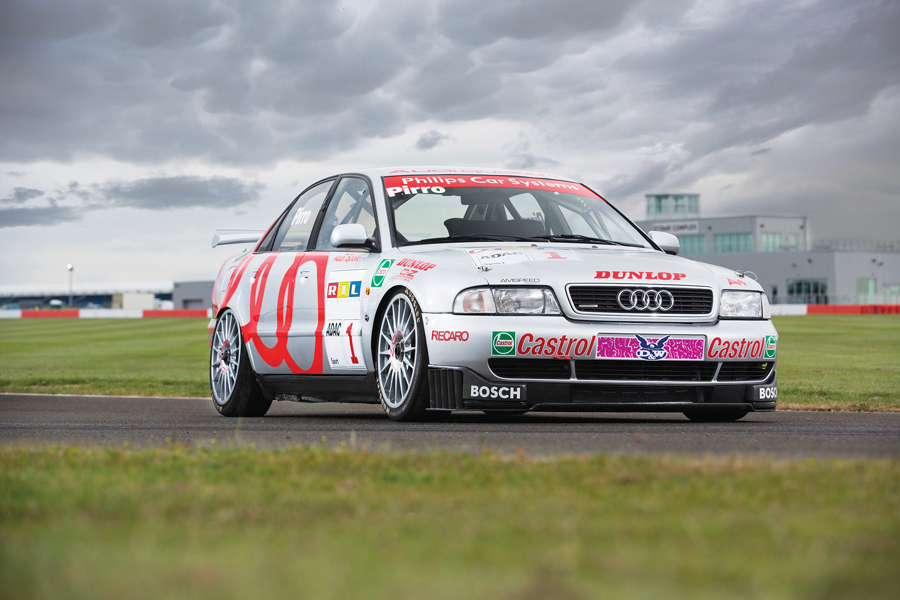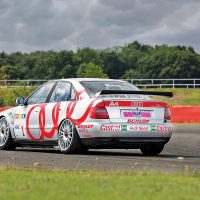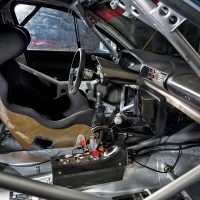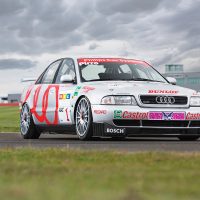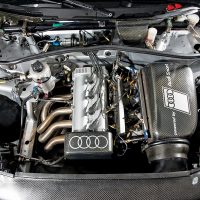SCM Analysis
Detailing
| Vehicle: | 1997 Audi A4 Quattro Super Touring sedan |
| Years Produced: | 1995–97 |
| Number Produced: | 31 |
| Original List Price: | The moon. They were that expensive to build |
| SCM Valuation: | Median to date, $152,879; high sale, $155,678 |
| Chassis Number Location: | In left door jamb. Original “WAUZZZ” factory number on bulkhead behind airbox |
| Club Info: | Touring Car Racing Europe |
| Website: | http://www.supertcc.com |
| Alternatives: | 1990–2000 Ford Mondeo, 1990–2000 Nissan Primera, 1990–2000 Vauxhall Vectra |
| Investment Grade: | C |
This car, Lot 115, sold for $150,080, including buyer’s premium, at RM Sotheby’s Battersea Park auction in London, England, on September 7, 2016.
Super Touring cars have to manage on only 2 liters, but earlier this year our subject Audi lapped Goodwood as fast as the winner of the GT40 race.
They look fairly standard, but within the sheet metal everything is bespoke, being hand-built at fantastic cost by the factory (Audi) or independent contractors (Ford, Nissan and just about everybody else).
The engines, which could be any 2-liter unit from the manufacturer’s group, are shifted backwards to help weight distribution, the driver sits more centrally while operating a slap-shift sequential ’box, and the anti-roll bar stiffness can be adjusted on the move.
Audi had a particular advantage with its Quattro system when tracks were wet, as the torque was shared around four wheels rather than just two, but the A4 isn’t as radical as some of the others.
Mondeos had Mazda V6 engines with custom-made heads (the first ones even ran as rear-wheel drive thanks to a 4×4 option on the books). The Nissan Primera used a unique lay-flat motor that lives mostly under what used to be the dashboard.
A short Golden Era
Costs had spiraled so far — Ford was reputed to have spent £12m running four cars in 2000 — that for 2001 the rules were redrawn with a simpler, much cheaper spec, and the Golden Era of Touring (BMW M3, Sierra Cossie RS500) and Super Touring cars was over.
Having done their initial tours of duty, older Touring and Super Touring cars tended to be pensioned off to race in some of the further-flung corners of the world. However, since the Historic Sports Car Club’s Super Touring series for cars built between 1990 and 2000 started in the U.K. in 2014, several have returned home to Europe.
Our subject car is one of them, although it hasn’t traveled as far as some of the others, such as the pair of Peugeot 406s that returned from Australia in 2013.
Tons of race history
According to www.supertouringregister.com, ST31 was the last of 31 A4 Quattro Super Tourers produced at Audi Sport. The car was built in February 1997.
Emanuele Pirro drove the car in the ADAC Super Tourenwagen Cup in Germany. Pirro switched to a front-wheel-drive car (SF33, one of half a dozen front-wheel-drive A4 Supertourings built) for the final three meetings, and his car was taken over by Philipp Peter.
For 1998 our subject car was sold to ISR Racing and run for Josef Venc to win the FIA Central European Zone Supertouring Championship under the Charouz Racing banner.
In 1999, TV host Christophe Dechavanne drove the car in the French Supertourisme Championship. In 2000, it returned to Charouz Racing for the Czech Championship before being sold to Anders Hammer, who used it in the 2001 and 2002 Swedish Touring Car Championship.
Between 2003 and ’04, Steve Hirst ran the car in Formula Saloons and Dutch Supercar Challenge events. In 2005–06, the car was driven by Giorgio Leonardi in the Italian Hillclimb Championship.
Dragan Milic bought it at the end of 2008 and ran in the Montenegro Hillclimb and Serbian Touring Car series until 2013, when it was sold to Jonny Westbrook, co-founder of Touring Car Racing Europe, which administers the U.K. Super Touring series.
Westbrook restored it in time for the 74th Goodwood Members’ Meeting in March 2016, where Pirro drove it once again in a high-speed demonstration.
Following that, Westbrook raced it to a podium finish at The Silverstone Classic in July.
Restored — but still a racer
The rebuild was on the original Matter-built shell taken back to bare metal, with every part refreshed and many original Audi Motorsport components retained, including the correct ECU, the major components being rebuilt by Karl Hasenbichler (of Audi Sport) in Germany.
Westbrook says he left a small amount of chassis damage at the front, sustained in Sweden, as a mark of its last competitive Touring car outing in period, but the overall appearance and finish was excellent for a racer.
Sold into a growing market
Our car fetched a below-estimate £112k, including premium. I mention the price in sterling to give the true picture, as the dollar/pound exchange rates have shifted so much in recent months due to market tremors following shock voting results on both side of the Atlantic.
By comparison, at Race Retro in 2015, ST07, the 1995 A4 Quattro Super Tourer Hans-Joachim Stuck drove in period in the German ADAC Super Tourenwagen Cup, sold for £101,250 (then $156k).
So the price for our subject car is in the right range, and you’d expect a factory-built Audi to fetch a bit more than a Prodrive Mondeo, although the actual sums here are trivial compared to what it cost to build them in the first place.
With two championships already running in Europe and another about to take place in Australasia, increased demand looks likely too soon push up prices. The Mondeo in the comps list went to New Zealand right after being raced in the 2016 Silverstone Classic.
Unless anything serious goes bang — such as the precious transmission, which is the most valuable part of a Super Touring racer — running them is not as expensive as you might think — provided you have spares, said Dave Jarman, TCRE co-founder.
At this auction, a package of spares was on offer from the vendor by separate negotiation. Westbrook was letting the car go, as he fulfilled an ambition to own one of the best. He still has a couple of other Super Touring racers, so he won’t be out of the game.
These are big boys’ toys indeed. We should be thankful that enough racers have the cojones to take on the challenge of owning and racing for our delight these technical — and very fast — marvels from one of saloon car racing’s greatest eras. Thank you, gentlemen. ♦
(Introductory description courtesy of RM Sotheby’s.)
